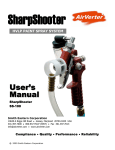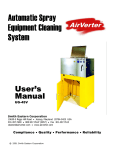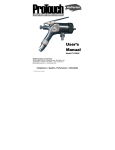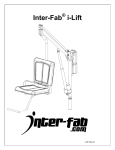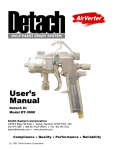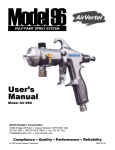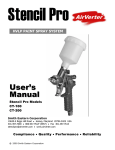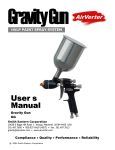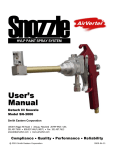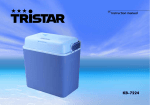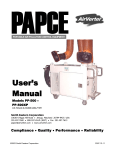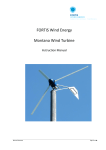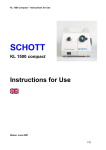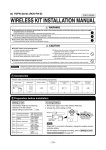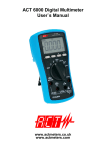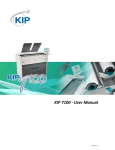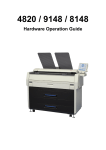Download User`s Manual
Transcript
PAPCE PORTABLE AIR POLLUTION CONTROL EQUIPMENT U s e r’ s Manual Model PP-150 Smith Eastern Corporation 10630-S Riggs Hill Road • Jessup, Maryland 20794-9425 USA 301.497.7600 • 800.937.HVLP (4857) • Fax 301.497.7613 [email protected] • www.airverter.com Compliance • Quality • Performance • Reliability ©2001 Smith Eastern Corporation 2002-03-14 AirVerter® Portable Air Pollution Control Equipment Please Read User's Manual BEFORE Using This Equipment WHEN IN THE PROXIMITY OF HAZARDOUS FUGITIVE EMISSIONS USE PROPER PERSONAL SAFETY EQUIPMENT INCLUDING RESPIRATOR, GOGGLES AND SAFETY CLOTHING. WARNING THIS EQUIPMENT IS OPERATED WITH HIGH VOLTAGE ELECTRICITY. ALWAYS TURN THE MACHINE "OFF" AND DISCONNECT POWER PRIOR TO MAINTENANCE OR REPAIR. WARRANTY Smith Eastern Corporation warrants to the Purchaser that Portable Air Pollution Control Equipment (PAPCE) is free from defects in material or workmanship under normal use and service for a period of twelve (12) months from the date of shipment. Should any failure appear during this period, Smith Eastern shall, if given prompt written notice by the Purchaser, correct such nonconformity by repair or replacement of the nonconforming part, F.O.B. Smith Eastern’s repair facility. Repair parts are warranted for ninety (90) days from the date of shipment, but repairs or replacements to original equipment shall not renew or extend the warranty period of such equipment. Equipment and parts furnished by Smith Eastern but manufactured by others shall be limited to the warranty offered by the manufacturer thereof. Smith Eastern reserves the right to limit this warranty in cases of misuse or abuse. Any modifications to equipment or recommended procedures will void the warranty. The foregoing warranty is exclusive and in lieu of other warranties of quality or performance, expressed, implied or statutory, including any warranties of merchantability or of fitness for a particular purpose. ABOUT PAPCE PAPCE is a California South Coast Air Quality Management District (SCAQMD) approved portable suction-type control device to capture fugitive vapor, mist, gases, fumes, odors, and other liquid and solid particulate matter from spraying, sanding, grinding, and welding operations. Contaminated air is drawn in through the exhaust hood and passes through the exhaust arm to the filter unit. Large particles are removed from the air stream by the pre-filter. The HEPA filter removes particles as small as .3 microns with 99% efficiency. An optional activated charcoal filter absorbs hazardous gases and fumes. Filtered air is then returned to the workplace. The articulating, selfsupporting duct arm provides maximum flexibility in a portable particulate capture device. 2 USE PERSONAL SAFETY EQUIPMENT AROUND HAZARDOUS EMISSIONS AirVerter® Portable Air Pollution Control Equipment WARNING Do not use this unit to extract easily flammable or explosive gases! Protect the Electrical Cable from heat, oil and sharp edges. Make sure the unit stands firmly and casters are locked when in operation. Do not operate unit without filters installed. Protect unit from dampness. Disconnect from electrical power before servicing unit. UNCRATING, ARM INSTALLATION AND POWER SUPPLY VERIFICATION Uncrate unit being careful not to damage the Casters, Duct Support Arm and Collection Hood. A. Verify all parts have been shipped and are not damaged 1. Duct, Support Arm and Collection Hood 2. Large Particulate Filter (Filter Compartment) 3. HEPA Filter (Filter Compartment) B. Attach Support Arm and Duct to the Swivel Mount (see instructions on Attaching Swivel Mounts and Support Arms. FILTER INSTALLATION Filters should be installed as follows: A. Install filters in the filter compartment bottom to top as follows: 1. HEPA Filter 2. Large Particulate Filter (Pre-Filter) - The pre-filter should be installed with the less dense side of the filter to the top and the more dense side of the filter to the bottom. B. If used, the Carbon Filter is installed below the HEPA Filter. Particulate Filter HEPA Optional Carbon Filter Figure 1 USE PERSONAL SAFETY EQUIPMENT AROUND HAZARDOUS EMISSIONS 3 AirVerter® Portable Air Pollution Control Equipment ATTACHING SWIVEL MOUNT AND SUPPORT ARM folded for shipment. CAUTION: Do Not allow arm to “Spring Open” when removing the tape and cords securing the arm for shipment. Equipment damage and/or personal injury may result from allowing the arm to spring open uncontrolled. Carefully unfold the structure and ensure it moves freely. Put the arm back in its folded position, as it will be easier to mount to the Swivel Base. CAUTION: Do not get fingers caught between arm support tubes. 1. The Swivel Base is in its own cardboard box for shipping with the mounting bolts enclosed in a plastic bag. 2. Securely mount the Swivel Base and Gasket using the hardware provided. The Swivel Base consists of two parts that allow the upper section of the swivel to move separately from the lower section. The Swivel Base has a rubber-band-style boot. The boot is used to slip over the groove between the upper and lower sections so air will not be drawn from the groove. The swivel should rotate freely after the arm and duct are installed. 3. The metal support structure for the arm is 4. There are (2) bolts, nuts, & (6) washers on the arm's Base Plate. Remove these components. These bolts are not tightened on the Base Plate for easy removal. SUPPORT ARM Center Plate Lower Support Structure Upper Support Structure Flexible Duct Base Plate Clamp Clamp Bolt Base Plate Here Swivel Base Rubber Boot Gasket Hood PAPCE Figure 2 4 USE PERSONAL SAFETY EQUIPMENT AROUND HAZARDOUS EMISSIONS AirVerter® Portable Air Pollution Control Equipment ATTACHING SWIVEL MOUNT AND SUPPORT ARM (continued) 5. The Base Plate has multiple holes for many mounting configurations. You will use holes 1 & 8 for mounting the arm to the PAPCE. Bolt the Base Plate/arm to the Swivel Base using the hardware and holes 1 & 8. Tighten the hardware snugly. 1 8 Figure 3 6. Extend the arm out by pulling on the lower support structure. If the arm does not stay in place, slightly tighten the friction pivots located on the Base Plate and the Center Plate. These pivots use brown friction washers. There are (2) pivots located on the Base Plate and the Center Plate. Simply adjust the pivot points until the arm holds itself. Final pivot adjustment is to be done at the end of assembly. 7. Slide the Flexible Duct over the arm and attach the duct to the Swivel Base by using the clamp provided. DO NOT ALLOW THE FLEXIBLE DUCT TO GO OVER THE GROOVE OR THE RUBBER BOOT THAT COVERS THE GROOVE ON THE SWIVEL BASE. 8. Mount the Hood using the hardware supplied with the Hood. Please note how the hardware is positioned so the Hood will move easily and stay at that point. Your Hood has a built-in damper. Sometimes the damper blade can be loose and may tend to close during use. Tighten the small screw on the damper lever so the damper will stay in its desired position, yet will move so the damper can be controlled. 9. The Hood has (2) pivot joints so the Hood can be moved up, down, left, and right, independent of the arm. The hardware that mounted the Hood to the Hood arm bar should be adjusted so the Hood can move side to side and hold its position 10. Final arm adjustment is based upon the arm holding itself in any position and not drifting. This will require the tightening or loosening of each of the pivot points located on the Base Plate, Center Plate, Hood arm bar, and Hood. The goal is to have the arm move as easily as possible and hold its position at the release point. The arm may need readjustment from time to time, dependent upon usage. 11. DO NOT OVER TIGHTEN THE FRICTION PIVOT JOINTS AS DAMAGE CAN OCCUR TO THE FRICTION WASHERS. IT IS ALWAYS BETTER TO TIGHTEN THE JOINTS A LITTLE AT A TIME TO GAIN THE DESIRED MOVEMENT. USE PERSONAL SAFETY EQUIPMENT AROUND HAZARDOUS EMISSIONS 5 AirVerter® Portable Air Pollution Control Equipment OPERATION INTAKE HOOD Position Intake Hood in close proximity to work area (ideally within 12-18 inches) for source capturing and extraction of welding smoke, dust, paint overspray and hazardous airborne fumes. Sanding Dust Capture Welding Fumes Extraction FILTER EFFICIENCY A. The Red Filter Monitor Light will illuminate when the filters are saturated. Change filters as required for optimum performance. B. The life of the Carbon Filter depends upon the application. The filter must be changed 6 whenever gases or fumes reappear in the cleaned air. The Carbon Filter should be changed at the same time as the main (HEPA) filter. USE PERSONAL SAFETY EQUIPMENT AROUND HAZARDOUS EMISSIONS AirVerter® Portable Air Pollution Control Equipment ILLUSTRATED PARTS BREAKDOWN SUPPORT ARM AND FLEXIBLE DUCT USE PERSONAL SAFETY EQUIPMENT AROUND HAZARDOUS EMISSIONS 7 AirVerter® Portable Air Pollution Control Equipment Part # NSN Description PP-006 4460-01-463-3165 Swivel Base and Gasket PP-007-106 - 6-in. x 10-ft. Flexible Duct PP-007-CL - Hose Clamp PP-008-10 4460-01-463-3241 Flexible Duct Support Arm PP-017 4330-01-467-6901 Large Particulate Filter (pre-filter) PP-018 4460-01-463-3194 Carbon Filter PP-019 4460-01-463-3190 HEPA Filter PP-022 4460-01-463-3168 Intake Hood 8 USE PERSONAL SAFETY EQUIPMENT AROUND HAZARDOUS EMISSIONS AirVerter® Portable Air Pollution Control Equipment LARGE PARTICULATE FILTER (PRE-FILTER) The Large Particulate Filter media is 100% polyester. The dual-stage, layered media has a less dense layer on the air-entering side and a denser layer on the air-leaving side. This density pattern prevents face loading as larger particles are trapped in the front layer and smaller particles in the back layer. Applications include: 1. Paint Overspray 2. Sanding Dust 3. Oil Mist 4. Adhesive Overspray Construction and Performance Data Media Size 24" x 24" x 1" Media 100% Polyester Resistance @ 400 FPM .20″ W.G. Paint Holding Capacity 2.7 lbs. Per Sq. Ft. HEPA FILTER HEPA filters used in these units are designed for use where higher airflow velocities occur offering the user a wide range of advantages, including: same amount of space, as do standard HEPA filters. This was accomplished through the use of a specially designed separator which allows up to 65% more media to be installed in a 24" x 24" x 11-1/2" area. • Higher air flow with no increase in resistance. • Higher velocities deliver up to 500 FPM while maintaining the highest efficiencies. The result for the user is a filter that lasts longer and will operate at a higher capacity than typical HEPA filters. The filter has only .72" W.G. resistance at 1100 CFM, compared to 1.0" W.G. of standard HEPA filters. The filter has more media area in the . Performance Data DIMENSIONS HxWxD 24 x 24 x 11-1/2 99.97% @ .3 Micron CAPACITY (CFM) @ Initial Pressure Drop 1.0" 1.35" 1500 2000 USE PERSONAL SAFETY EQUIPMENT AROUND HAZARDOUS EMISSIONS 9 AirVerter® Portable Air Pollution Control Equipment ACTIVATED CARBON FILTER Carbon Filters are designed for odor removal only. They are not for particulate collection. Odor removal is a direct function of the amount of carbon exposed to the air stream. Carbon filters are designed for light to moderate odor conditions in multi-stage filtration systems where other filters are installed upstream from the carbon filters. The Activated Carbon Filter has 1 1/3 pounds of carbon per square foot in a 2" thick pad (600 grams per sq. ft. of filter face area). Each filter is sealed to prevent adsorption from occurring prior to installation. Other filters are necessary to remove particulate contaminants from the air to prevent coating the microscopic carbon pore structure. Performance Data - 2" Filter Based on ASHRAE Standard 52.1-1992. Tolerances conform to ARI Standard 850.84 Recommended Final Resistance 1.2" W.G. Activity Rating Minimum 60% on carbon tetrachloride at 251C. UL Classification UL Class 2 According to UL Standard 900 Recommended Temperature Limit 120 F (491 C). TROUBLESHOOTING Problem Unit Fails To Start Probable Cause Remedy 1. Breaker Tripped 1. Reset Breaker 2. Improper/Faulty Electrical Connection 2. Repair/Replace Electrical Connections. 1. Incorrect Power Supply 1. Ensure Unit Connected To Correct Power Supply 2. Breaker Tripped 2. Reset Breaker 1. Filter Clogged 1. Replace Clogged Filter 2. Ducts Blocked 2. Remove Blockage Odor Detected* 1. Carbon Filter Saturated 1. Change Carbon Filter Loud Clanking Noises 1. Object Obstructing Rotation Of Blower 1. Remove Object To Allow Blower To Rotate Freely 2. Blower Misaligned 2. Adjust Blower To Proper Position On Motor Shaft Unit Stops Running No/Low Air Flow *Carbon Filter usage is optional. Check local requirements. 10 USE PERSONAL SAFETY EQUIPMENT AROUND HAZARDOUS EMISSIONS AirVerter® Portable Air Pollution Control Equipment NOTES USE PERSONAL SAFETY EQUIPMENT AROUND HAZARDOUS EMISSIONS 11













